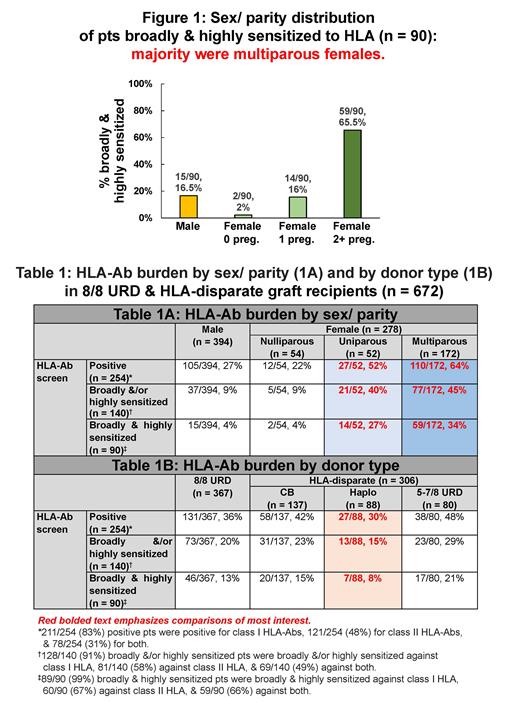Introduction: The relationship between allograft patient (pt) demographics & HLA-antibody (HLA-Ab) burden, & the degree to which HLA-Ab burden impacts donor type received in the current era of “donors for all”, is not established.
Methods: We examined associations between pt sex/ parity, ancestry, & HLA-Ab burden in consecutive adult allograft recipients (excluding HLA-identical siblings) with acute leukemia, MDS, or MPN, transplanted 1/2018-12/2022. We also assessed the impact of HLA-Ab burden on donor type received. We classified HLA-Ab burden by the number & intensity of class I (HLA-A, B, -C) & II (HLA-DR, -DQ, -DP) HLA-Abs. A mean fluorescence intensity (MFI) > 1,000 defined a positive HLA-Ab. Pts were classified as broadly sensitized (more than the median number of class I/ II HLA-Abs among Ab positive pts) &/or highly sensitized (MFI > 10,000 for ≥ 1 HLA-Ab). For pts with > 1 screen, the one closest to transplant was used. We hypothesized that multiparous females have the greatest HLA-Ab burden, limiting provision of haploidentical (haplo) grafts in these pts due to the rejection risk.
Results: Of 672 pts [median age 60 yrs (range 29-79), 419/672 (62%) with acute leukemia, 472/672 (70%) with European ancestry], 278/672 (41%) were female of whom 54/278 (19%) were nulliparous, 52/278 (19%) uniparous & 172/278 (62%) multiparous. Overall, 367/672 (55%) received 8/8 unrelated donor (URD) & 305/672 (45%) HLA-disparate grafts [137 cord blood (CB), 88 haplo, & 80 5-7/8 URD (mmURD)]. As expected, non-European pts received 2x the proportion of HLA-disparate grafts [165/472 (35%) vs 141/200 (70%), p < .001].
Pt ancestry was not associated with HLA-Ab burden. Pt sex/ parity & HLA-Ab burden associations are shown in Table 1A & Fig. 1. Over one third [254/672 (38%)] of pts had a positive screen for class I/ II HLA-abs (median of 8 HLA-Abs of positive pts, range 1-113). In the 254 positive pts, 3,563 Abs were detected with the MFI distribution being 1,001-4,000 in 1,340/3,563 (38%), 4,001-10,000 in 874/3,563 (25%) & > 10,000 in 1,349/3,563 (38%). Of the total pt cohort, 140/672 (21%) pts were broadly &/or highly sensitized with 90/672 (13%) being both broadly & highly sensitized. Compared with males & nulliparous females, uni- & multi-parous female pts had over 2x the proportion of positive screens [117/448 (26%) vs 137/224 (61%), p < .001]. They also had more than 8x the proportion broadly & highly sensitized [17/448 (4%) vs 73/224 (33%), p < .001].
HLA-Ab burden by donor type is shown in Table 1B. Among HLA-disparate graft recipients, compared with recipients of CB & mmURDs, fewer haplo recipients had positive screens [96/217 (44%)CB/ mmURD vs 27/88 (31%) haplo, p = .029]. Less than half the proportion were broadly & highly sensitized [37/217 (17%) CB/ mmURD vs 7/88 (8%) haplo, p = .041]. Also, haplo recipients included the fewest multiparous females [16/88 (18%)] compared with making up over one quarter of 8/8 URD [98/367 (27%)], CB [36/137 (26%)], or mmURD [22/80 (28%)] transplants.
Conclusion: Over 10% of transplanted pts were broadly & highly sensitized to HLA. The HLA-Ab burden was predominantly in parous females (33% of our pt cohort), most of whom had HLA-Abs with one-third of this group being both broadly & highly sensitized. Moreover, pts with a high HLA-Ab burden were the least likely to receive haplos, & thus these transplants were less common in multiparous females. These data have immediate implications for alternative donor transplant evaluations of female patients: given that HLA-Abs should be expected among parous females, in the absence of a matched adult donor, mmURD or CB may need to be considered over haplo grafts. This could compound allograft access for multiparous female pts of non-European heritage, given many will lack a fully matched adult donor & non-European pts have greatly decreased URD availability (Fingrut et al., ASH 2023). These challenges are under-appreciated in the transplant field. At initial allograft evaluation, transplant centers should obtain ancestry & parity histories & screen for HLA-Abs. In the absence of a suitable HLA-identical sibling donor, this information, together with the URD search prognosis (ie Davis et al., TCT 2023), should then guide triage to alternative donor allografts. Finally, prospective analysis of the impact of donor-specific HLA-Abs on donor selection & transplant outcomes as well as development of effective HLA de-sensitization strategies are urgently needed.
Disclosures
Politikos:Merck: Research Funding; ExcellThera: Other: Membership on Data and Safety Monitoring Board . Shaffer:Gamida Cell: Consultancy, Research Funding; Hansa Biopharma: Consultancy. Barker:Gamida Cell: Consultancy; New York Blood Center: Consultancy; Merck: Research Funding.


This feature is available to Subscribers Only
Sign In or Create an Account Close Modal